Texas is a lively playground for all kinds of wildlife, and squirrels are among the most charming residents you’ll encounter. From the busy gray squirrels scampering through oak trees to the rock squirrels peeking out from desert crevices, the state hosts an impressive variety. In this guide, we’ll explore the types of squirrels in Texas—how to identify them, where they live, what they eat, and how they behave. Whether you’re an outdoor enthusiast, a backyard bird watcher, or simply curious about the furry acrobats you see darting up trees, this detailed review will help you recognize and appreciate each species that calls the Lone Star State home.
1. Eastern Gray Squirrel (Sciurus carolinensis)
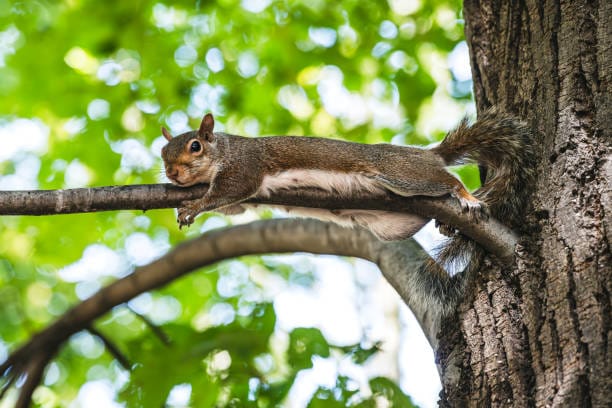
Physical Characteristics & Identification Tips
The Eastern Gray Squirrel is often the first squirrel most Texans notice in city parks and suburban backyards.
Behavior
Known for its curiosity and daring nature, the Eastern Gray Squirrel spends much of its day exploring trees, burying acorns, and performing gymnastic-like leaps. They’re crepuscular, meaning most active during early morning and late afternoon. When alarmed, they freeze, flick their tails, and emit sharp barks to warn nearby squirrels. In urban areas, they’ve learned to navigate fences, roofs, and even bird feeders like seasoned acrobats. Watching one hang upside down while raiding a feeder can be quite a comedy show.
Habitat and Range
This species thrives in the eastern and central parts of Texas, favoring mixed hardwood forests, pecan groves, and shaded city parks. They build “dreys,” or leafy nests, high in tree forks and often share them during cold snaps. Because of their adaptability, they’ve expanded from natural forests to neighborhoods across Houston, Austin, and Dallas. If you have large oaks nearby, chances are you’ve got a gray squirrel neighbor.
Diet
Gray squirrels have diverse tastes. They feast on acorns, pecans, hickory nuts, berries, and fungi, occasionally sampling bird eggs or insects when other food is scarce. Their food-hoarding behavior—burying nuts in scattered spots—is vital for forest regeneration, as many forgotten seeds eventually sprout into new trees. So, in a way, they’re accidental gardeners of the Texas woodlands.
Reproduction and Life Cycle
Breeding peaks twice a year—late winter and midsummer. After a gestation of about 45 days, females give birth to litters averaging three to five young. Babies are born hairless and blind, fully dependent on their mothers. Within two months, they’re climbing, leaping, and testing their limits—sometimes too enthusiastically for their own good. Most live up to six years in the wild, though many fall prey to hawks, snakes, and cars.
Fun Facts / Unique Traits
Eastern Gray Squirrels possess an uncanny sense of smell that allows them to relocate buried nuts months later, even under snow or mulch. They also communicate with an intricate mix of tail flicks and chirping sounds. Researchers have even compared their problem-solving ability to that of small monkeys. So if you’ve ever been outsmarted by one stealing from your feeder, don’t take it personally—it’s practically a genius with fur.
Human Interaction
Gray squirrels coexist comfortably with people, often becoming local park mascots. Some individuals grow bold enough to approach picnickers for handouts, though feeding wildlife is discouraged. They’re occasionally labeled as nuisances when nesting in attics, but humane exclusion methods usually solve the issue. Overall, their charm outweighs their mischief, making them one of the most beloved wild neighbors in Texas.
2. Fox Squirrel (Sciurus niger)

Physical Characteristics & Identification Tips
The Fox Squirrel is the heavyweight champion of Texas tree squirrels. Larger than the Eastern Gray, adults can stretch 20 to 26 inches and weigh nearly 2 pounds. Their fur varies dramatically—some appear rusty-red or orange-brown, others dark gray with black masks and creamy bellies. The name “fox” comes from this reddish hue reminiscent of a red fox’s coat. Their thick tails are broad and fluffy, often with a black edge. Up close, you’ll notice a sturdy jawline and powerful front teeth built for cracking the toughest pecans.
Behavior
Fox Squirrels are deliberate movers. Unlike the frenetic energy of grays, they often pause between leaps, as if measuring each jump. They prefer solitary living except during breeding or in shared winter dens. Their daily routine follows a rhythm—feed early, rest midday, feed again in late afternoon. When threatened, they scurry up the nearest tree, flatten against the bark, and rely on camouflage rather than fleeing outright. And if you’ve ever seen one stretch out flat on a branch in summer, it’s not tired—it’s “splooting” to cool off.
Habitat and Range
Fox Squirrels are widespread across nearly all of Texas, except in extreme western deserts. They thrive in open woodlands with scattered trees—oak, pecan, or pine—and often inhabit farmland edges or golf courses. Because they adapt to a variety of climates, you might see them in both humid East Texas forests and drier Hill Country scrublands. They’re frequent companions in small towns where mature shade trees are plentiful.
Diet
This species is a professional forager. Nuts and seeds make up most of its diet, but it won’t turn down corn, buds, or the occasional insect. They crack pecans like seasoned mechanics and bury surplus food in shallow caches for later. Their strong jaw muscles can slice through hickory shells that would defeat most other rodents. Occasionally, they raid bird nests or sample fungi growing near roots.
Reproduction and Life Cycle
Fox Squirrels typically breed twice yearly. Females can produce litters of two to four kits, which grow rapidly thanks to their rich milk. Young squirrels leave the nest after 8–10 weeks, immediately joining the climbing and caching routines of adults. Their lifespan averages around eight years, although few reach that in the wild due to natural predators and habitat loss.
Fun Facts / Unique Traits
While many squirrels are agile jumpers, Fox Squirrels rely more on muscle than momentum. Their impressive strength allows them to break open fruits others can’t manage. Interestingly, they exhibit “melanism”—some populations in East Texas have nearly black coats. Their presence in folklore is equally colorful: early settlers admired them as symbols of persistence and resourcefulness. One might say the Fox Squirrel embodies the Texas spirit itself—independent, adaptable, and tough.
Human Interaction
Farmers often see them as both allies and adversaries. They help disperse seeds yet sometimes raid cornfields or fruit trees. Urban dwellers, meanwhile, enjoy their bold personalities; these squirrels often approach humans out of curiosity. They’re a favorite subject for wildlife photographers because of their expressive faces and fearless demeanor. Whether you find them charming or cheeky, it’s impossible to ignore them once they claim your backyard tree.
3. Southern Flying Squirrel (Glaucomys volans)
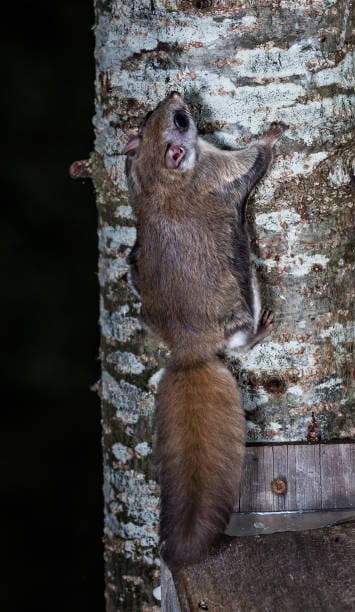
Physical Characteristics & Identification Tips
Among all squirrels in Texas, the Southern Flying Squirrel wins the award for stealth and surprise. Despite its name, it doesn’t truly fly—it glides using a thin flap of skin called the patagium that stretches between its wrists and ankles. When fully extended, this skin acts like a parachute, allowing them to glide over 150 feet between trees. Adults are tiny, weighing less than 3 ounces, with silky gray-brown fur, huge black eyes adapted for night vision, and a flattened tail that functions as a rudder mid-glide. Spotting one in the wild feels like catching a glimpse of a forest phantom.
Behavior
Nocturnal by nature, these squirrels wake at dusk to forage. Their movements are quiet, ghostlike, as they leap and glide from branch to branch. They communicate using high-pitched squeaks often inaudible to humans. Unlike most squirrels, Southern Flyers are social creatures—during winter, groups of ten or more may huddle together in tree cavities to share warmth. Their playful glides across moonlit clearings look almost like aerial choreography, something one might compare to a “forest ballet.”
Habitat and Range
Southern Flying Squirrels inhabit mature hardwood forests in eastern Texas, especially areas rich in oaks and hickories. They prefer old trees with natural hollows, often choosing abandoned woodpecker holes as nesting sites. Though rarely seen, evidence of their presence appears through gnawed nuts and faint gliding marks on trunks. You’re more likely to hear their faint squeaks or rustling than to see them directly.
Diet
They enjoy a varied diet that includes nuts, seeds, fruits, insects, and even bird eggs. During warm months, they feast on berries and tree sap; in winter, cached acorns sustain them. They’re also partial to mushrooms, playing an important role in dispersing fungal spores essential for healthy forest soils. In captivity or rehabilitation centers, they’re often offered a mix of nuts, fruit, and mealworms to mimic their omnivorous tastes.
Reproduction and Life Cycle
Breeding season runs from late winter into summer. Females typically raise two litters per year, each with two to six kits. The young remain in the nest for about five weeks before attempting their first glides—a nerve-wracking debut that usually ends with a soft thump or two. Lifespan averages around five years in the wild, longer in captivity.
Fun Facts / Unique Traits
Flying squirrels have specialized cartilage at the wrist that extends the gliding membrane. When airborne, they spread their limbs to form a perfect square, steering by adjusting tail and limb angles. Their glides can exceed 200 feet with remarkable precision, often landing exactly where intended. Another quirk? Their fur glows pink under ultraviolet light—a mystery that still fascinates biologists.
Human Interaction
Because they’re nocturnal and shy, most Texans never realize they share their neighborhoods with these tiny gliders. Occasionally, they take up residence in attics, but humane exclusion and nest boxes placed outdoors can encourage them to relocate. Observing them at night with a red-filtered flashlight reveals an entirely different side of Texas wildlife—quiet, delicate, and astonishingly graceful. For many nature lovers, spotting a Southern Flying Squirrel ranks among the most magical experiences in the state’s forests.
4. Rock Squirrel (Otospermophilus variegatus)

Physical Characteristics & Identification Tips
Among all the types of squirrels in Texas, the Rock Squirrel might be the most rugged-looking of the bunch. It’s built for life among cliffs and rocky outcrops, giving it a stockier frame and shorter tail than its tree-dwelling cousins. Adults can reach up to 21 inches in length, weighing about 1.5 pounds. The fur is mottled gray and brown, creating perfect camouflage against stone and sand. Its face is pale with dark patches around the eyes, and its belly often carries a faint tan or cinnamon hue. If you catch one sunbathing on a boulder, don’t mistake it for a groundhog—it’s a true squirrel, just with mountain manners.
Behavior
Rock Squirrels are diurnal but cautious, always keeping an eye on predators. They tend to live in colonies and communicate using high-pitched warning whistles. Unlike tree squirrels, they spend much of their time on the ground, darting between crevices and shrubs. They’re expert diggers, crafting extensive burrow systems under rocks and ledges for shelter and food storage. During summer heat, they rest in their burrows for long stretches—almost a desert-style siesta. And if you ever see one stand upright, tail flicking, and barking sharply, it’s probably warning the entire colony of your presence.
Habitat and Range
This hardy species is mostly found in western and central Texas, thriving in arid and semi-desert landscapes such as the Edwards Plateau, Trans-Pecos region, and hill country canyons. They prefer rocky hillsides, dry creek beds, and scrub-covered slopes. You’ll rarely find them in lush forests; instead, think of places where lizards and prickly pears coexist. Their burrows can stretch for several meters, often with multiple entrances cleverly concealed among rocks.
Diet
Rock Squirrels are omnivores with flexible tastes. Their diet includes seeds, nuts, fruits, cactus pads, and occasionally insects or bird eggs. They’re particularly fond of mesquite beans and prickly pear fruit, which they skillfully peel to avoid the spines. In late summer, they collect seeds and store them deep underground to survive the leaner months. Unlike tree squirrels, they rarely bury single nuts; instead, they maintain entire “pantries” beneath the soil.
Reproduction and Life Cycle
These squirrels breed twice a year—in spring and mid-summer—producing litters of five to seven young after a gestation of about 30 days. The pups remain in burrows for their first month, emerging only once they’re strong enough to handle the harsh terrain. Their average lifespan is around four to six years, though some hardy individuals live longer in protected colonies.
Fun Facts / Unique Traits
Rock Squirrels are remarkable climbers, scaling cliffs with ease using sharp claws and powerful hind legs. In desert folklore, they’re sometimes called “stone shadows” because they vanish into crevices the moment they sense danger. They’re also known for their dramatic alarm calls—sometimes sounding like a series of quick sneezes. And yes, they do love to sunbathe; it’s believed the warmth helps rid them of parasites and stiff muscles.
Human Interaction
Because they often live near ranches and hiking trails, Rock Squirrels occasionally become bold around humans. Some may raid campsites for food, while others simply watch curiously from their rocky thrones. Farmers in dry regions sometimes consider them pests due to burrowing under irrigation structures, but overall, they’re more admired than resented. Spotting a Rock Squirrel perched on a ledge at Big Bend National Park is one of those “only in Texas” moments for wildlife watchers.
5. Mexican Ground Squirrel (Ictidomys mexicanus)
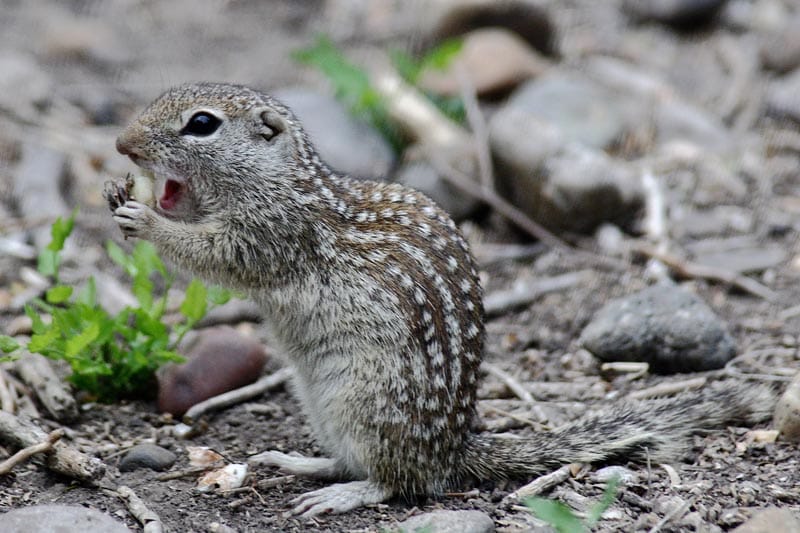
Physical Characteristics & Identification Tips
The Mexican Ground Squirrel is a sleek, spotted beauty often mistaken for a chipmunk because of its smaller size and patterned fur. Adults average 9 to 11 inches long with short tails and bodies covered in light brown fur dotted with white spots. A faint line of stripes runs down their back, giving them a speckled, glittering appearance in sunlight. Their ears are small and rounded, and their eyes large—perfect for scanning the open fields they love to inhabit. When sitting upright on their hind legs, they resemble tiny prairie sentinels surveying their domain.
Behavior
Unlike the more arboreal squirrels, Mexican Ground Squirrels are true earth-dwellers. They spend most of their lives on the ground, darting between burrows and feeding patches. These squirrels are solitary but tolerant; several may live in the same field without much conflict. During hot midday hours, they retreat underground to escape the heat, emerging again in the cooler morning and evening hours. They’re also known for their characteristic “tail-flagging” display—raising and twitching their tail rapidly when startled, as if waving a white flag of warning to others.
Habitat and Range
This species is common throughout south-central and western Texas, especially in areas bordering Mexico. It prefers grasslands, agricultural fields, and open scrublands. Because of its adaptability, it can even thrive in roadside embankments and golf courses, wherever the soil is soft enough to dig. Their burrows are deep and complex, often leading to multiple chambers used for nesting, storage, and escape routes from predators like hawks and snakes.
Diet
Mexican Ground Squirrels are opportunistic feeders. They consume seeds, grains, green vegetation, and insects. Farmers sometimes spot them nibbling on wheat or alfalfa crops, though they also help by eating harmful beetles and grasshoppers. They gather seeds in their cheek pouches to transport them to storage chambers—an impressive feat considering how much they can carry for their size. Like many squirrels, they prepare for lean seasons by creating multiple food caches.
Reproduction and Life Cycle
Breeding begins in spring, typically between March and May. After a gestation period of around 30 days, females produce litters averaging seven to ten pups. The young mature quickly, reaching independence after six weeks. Interestingly, Mexican Ground Squirrels may enter short hibernations or “torpor” during extreme heat or drought, reducing their metabolic rate to conserve energy. In favorable conditions, they can live up to five years in the wild.
Fun Facts / Unique Traits
These squirrels are one of the few species that perform “snake-avoidance” displays—flattening their bodies and vibrating their tails to appear larger when confronted by rattlesnakes. Biologists have observed them even kicking sand at the snake to distract it before escaping. They’re also excellent diggers, capable of excavating tunnels over six feet long with multiple exits. Their burrows often provide shelter to other small animals once abandoned, making them ecological engineers of the prairie ecosystem.
Human Interaction
While occasionally seen as pests in agricultural zones, Mexican Ground Squirrels play an important ecological role by aerating soil and dispersing seeds. Ranchers sometimes notice their burrow mounds but often tolerate them, knowing their benefits outweigh minor crop damage. Bird watchers and photographers appreciate them for their charming poses and lively antics. If you drive through rural Texas on a summer morning, you might see dozens standing at attention along fence lines—like tiny soldiers greeting the sunrise.
6. Thirteen-Lined Ground Squirrel (Ictidomys tridecemlineatus)
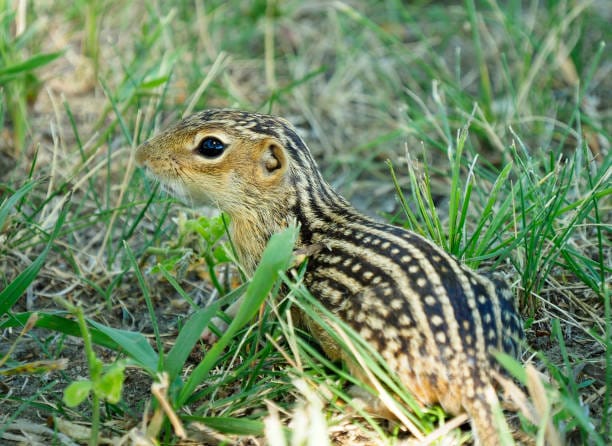
Physical Characteristics & Identification Tips
This small, vividly patterned squirrel is instantly recognizable by its alternating stripes and spots—thirteen of them, to be exact. Running from head to rump, seven dark brown or black stripes alternate with six tan or white ones, each dotted with pale spots. This dazzling pattern earned it the nickname “striped gopher” in some regions. Adults measure around 9 to 12 inches long and weigh less than a pound. Their tails are shorter than those of tree squirrels but densely furred. When they stand upright, you can almost count the stripes like reading a barcode of nature.
Behavior
Thirteen-Lined Ground Squirrels are active, alert, and surprisingly fast. They’re primarily diurnal, emerging after sunrise to feed and disappearing underground by evening. Unlike some of their Texan cousins, they undergo true hibernation during winter—sometimes for up to six months. When awake, they’re vocal and inquisitive, often chirping softly while feeding or standing guard. Their hibernation process is fascinating: body temperature drops near freezing, and heart rate slows dramatically, allowing them to survive cold northern Texas winters.
Habitat and Range
This species prefers open grasslands, pastures, and golf courses, mostly in northern and eastern Texas. They avoid heavily wooded areas, favoring places with low vegetation and sandy soils ideal for digging. You can often spot them near roadsides where grassy medians provide good visibility and drainage. Their burrow entrances are small and inconspicuous—sometimes hidden beneath tufts of grass—to protect against hawks, owls, and coyotes.
Diet
The Thirteen-Lined Ground Squirrel has a wide-ranging diet that includes seeds, grasses, insects, and even small vertebrates. Grasshoppers, crickets, and beetles make up a large portion of their summer diet, giving them a protein boost before hibernation. They also stash seeds underground for emergencies. Their feeding behavior contributes to seed dispersal and pest control, making them a subtle yet significant ally to Texas farmers.
Reproduction and Life Cycle
Breeding occurs soon after hibernation ends, usually in late March or April. Females bear one litter per year of seven to nine young. By midsummer, juveniles are already foraging independently, building fat reserves for their first winter sleep. Life expectancy is typically three to five years, though their secretive nature helps many escape predators like hawks and weasels.
Fun Facts / Unique Traits
Scientists study this species extensively for insights into hibernation and metabolic control. Its ability to lower heart rate and survive near-freezing body temperatures without tissue damage has even inspired medical research into organ preservation. In folklore, they’re known as “sleepy sentinels” of the prairie—vanishing underground each fall, then reemerging in spring as a sign that winter has truly passed. Watching one pop out of a burrow and stretch in the morning sun is a small but delightful reward for patient observers.
Human Interaction
Thirteen-Lined Ground Squirrels often coexist peacefully with humans, especially on golf courses and parklands. While they occasionally nibble on garden seeds, their burrows usually cause little harm. Many Texans enjoy spotting them on quiet country roadsides, where their quick dashes and chirping calls add life to the landscape. They’re shy but photogenic, and if you sit still long enough, you might see one standing upright, nose twitching, as if posing for its next field portrait.
7. Spotted Ground Squirrel (Xerospermophilus spilosoma)
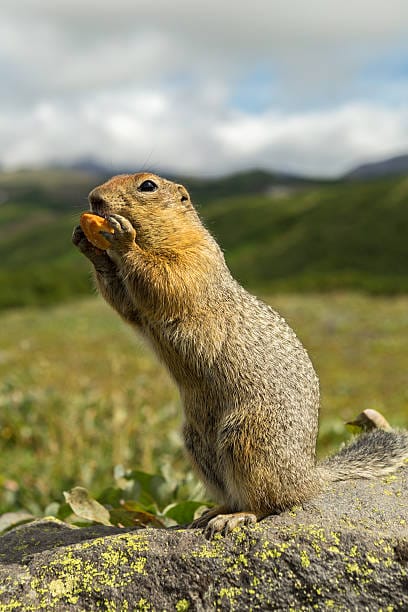
Physical Characteristics & Identification Tips
The Spotted Ground Squirrel is one of the smallest and most elusive squirrels in Texas. Measuring about 8 to 10 inches from nose to tail, it sports a slender body covered in light brown fur sprinkled with small white spots—an effective camouflage against sandy soils. Its tail is short and fine, with sparse hair that appears almost brush-like at the tip. Large eyes and small rounded ears give it a distinctly alert expression. At first glance, you might miss it entirely—it blends seamlessly into the desert terrain.
Behavior
Unlike the busy chatterers of the forest canopy, the Spotted Ground Squirrel lives a quiet, secretive life. It spends much of the day underground or darting between tufts of grass, surfacing briefly to feed. These squirrels are solitary, and their burrows can be shallow or deep depending on soil conditions. In hotter months, they enter short bouts of torpor—periods of inactivity to escape extreme heat and conserve energy. Their movements are quick and jerky, giving them a “stop-and-go” style that makes them hard for predators to catch.
Habitat and Range
Spotted Ground Squirrels thrive in the arid landscapes of western Texas, especially in sandy desert flats, scrublands, and dry prairies. They favor loose soils for easy digging and open areas where their excellent vision can detect threats from a distance. You’ll often find them near Big Bend National Park, the Trans-Pecos region, and parts of the Llano Estacado. Their burrow entrances are small and sometimes hidden beneath desert shrubs.
Diet
These small squirrels feed primarily on seeds and green vegetation, though they also enjoy insects when available. They’re particularly fond of desert plant seeds, grasses, and small roots. During the brief spring bloom, they gorge on tender shoots to build fat reserves for the harsh summer. They gather and store food within their burrows, ensuring a steady supply during dry spells when surface vegetation disappears.
Reproduction and Life Cycle
Spotted Ground Squirrels breed once annually, typically in early spring. After a gestation of about 28 days, females produce litters of five to seven pups. The young remain underground for several weeks before venturing above ground. Life expectancy is relatively short—around three years—but their high reproductive rate helps sustain stable populations in harsh desert conditions.
Fun Facts / Unique Traits
This species can survive extended periods without drinking water, deriving most of its hydration from plants and seeds. It also uses its tail as a sunshade when standing upright, positioning it over its back to reduce exposure to direct sunlight. Observers often describe its behavior as “nervous” or “bouncy,” with short, stuttering movements that make it look almost like it’s dancing on the sand.
Human Interaction
Because of their remote desert habitat, Spotted Ground Squirrels rarely come into conflict with humans. They’re an important part of the desert ecosystem, helping disperse seeds and serving as prey for snakes, hawks, and foxes. In some arid regions of Texas, wildlife photographers consider spotting one a special treat—it’s a small, shy creature perfectly adapted to a land of extremes.
8. Texas Antelope Squirrel (Ammospermophilus interpres)
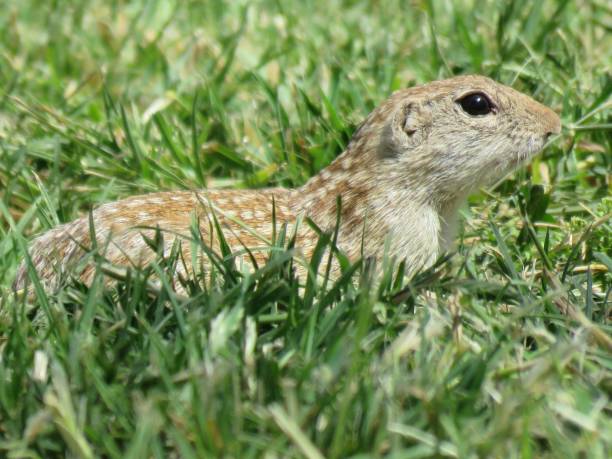
Physical Characteristics & Identification Tips
Compact and energetic, the Texas Antelope Squirrel is a small ground squirrel easily identified by its bold white side stripe and short, bushy tail. Its upper body is grayish-brown, while its belly glows with a pale cream hue. Adults measure roughly 9 to 11 inches long, weighing less than half a pound. Its large eyes and short ears are adaptations for life in bright, open desert areas. When alarmed, it often runs with its tail arched over its back—a signature behavior that makes it look a bit like a tiny antelope bounding across the sand.
Behavior
These squirrels are diurnal and incredibly active, especially during early morning and late afternoon when desert temperatures are manageable. They’re solitary but tolerant of others, often foraging in the same area without confrontation. Despite the heat, they don’t hibernate—instead, they seek refuge in cool underground burrows during the hottest part of the day. One of their most endearing behaviors is sand bathing: rolling in loose sand to remove oils and stay cool.
Habitat and Range
The Texas Antelope Squirrel is native to western and southwestern Texas, particularly in the Chihuahuan Desert and rocky foothills near El Paso. It favors arid habitats with sparse vegetation, including desert grasslands and cactus-studded slopes. Its burrows are shallow, often hidden beneath rocks or shrubs. These tunnels serve as safe retreats and food storage sites during dry months.
Diet
Though small, this squirrel has a broad palate. It eats seeds, fruits, green plants, and insects. It’s especially fond of mesquite beans and cactus fruit, which provide both food and moisture. Like many desert dwellers, it can survive long periods without free-standing water. During summer, it’s not uncommon to see one gnawing on cactus pads, skillfully avoiding the spines.
Reproduction and Life Cycle
Texas Antelope Squirrels typically breed once a year, between February and May. After a gestation of about 30 days, the female gives birth to four to six pups. The young grow quickly, emerging above ground within six weeks. Adults can live up to six years in the wild—a relatively long lifespan for a desert rodent. Their strong burrowing instinct and cautious nature help them evade many predators.
Fun Facts / Unique Traits
Despite the name, this species isn’t related to antelopes—it earned the moniker because of its bounding, graceful movement across open ground. It’s also one of the few squirrels known to cache food above ground, sometimes tucking seeds into rock crevices rather than burying them. When threatened, it may emit sharp squeaks and flick its tail repeatedly to confuse predators like snakes or kestrels.
Human Interaction
Encounters between humans and Texas Antelope Squirrels are rare but delightful. Hikers in desert parks often spot them perched on rocks, scanning their surroundings with comical intensity. They’re not considered agricultural pests and pose no threat to crops, making them one of Texas’s more beloved small mammals. Their presence signals a healthy desert ecosystem.
9. Rio Grande Ground Squirrel (Otospermophilus variegatus grammurus)
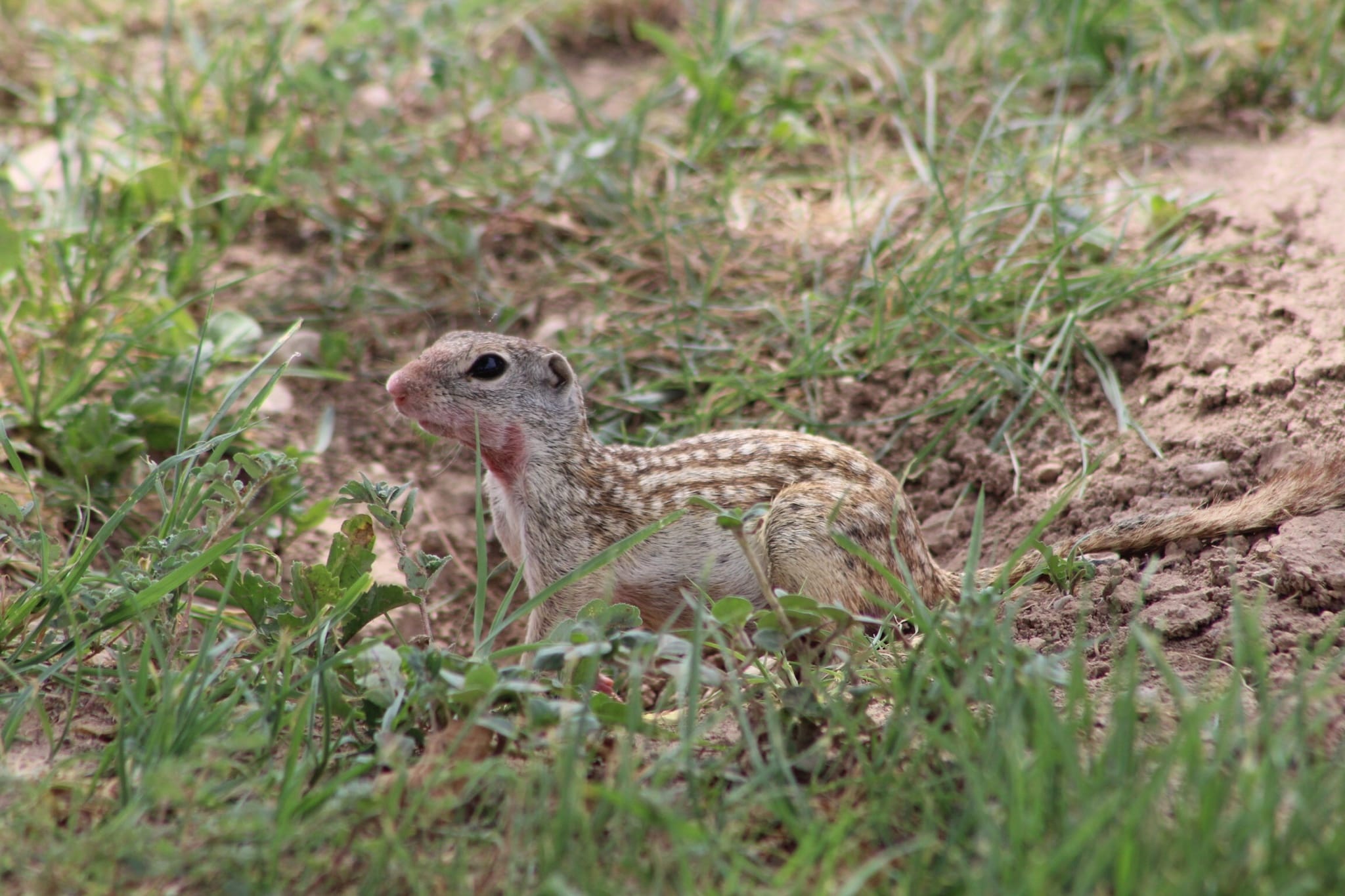
Physical Characteristics & Identification Tips
This lesser-known subspecies of the Rock Squirrel thrives along the Rio Grande Valley and southern Texas. It looks similar to its cousin but has a lighter coat with more pronounced mottling. Measuring up to 20 inches in total length, the Rio Grande Ground Squirrel combines strength and agility, with strong forelimbs adapted for digging and climbing. Its tail is long and fluffy, helping with balance and communication.
Behavior
The Rio Grande Ground Squirrel lives both above and below ground, dividing its time between foraging and resting in elaborate burrows. They’re highly social animals, often forming loose colonies with shared warning systems. Their sharp, whistling calls serve as both alarms and territorial markers. In contrast to the reclusive desert species, this squirrel shows remarkable curiosity and can become habituated to human presence in parks and ranchlands.
Habitat and Range
As its name suggests, this squirrel is found along the Rio Grande corridor and throughout southern Texas, where riparian zones and semi-arid scrublands provide ideal conditions. It thrives in mixed terrain—rocky slopes near water sources or the edges of agricultural fields. These squirrels are also common in south Texas ranchlands, where they use irrigation ditches and embankments for burrowing.
Diet
The Rio Grande Ground Squirrel’s diet includes seeds, nuts, cactus fruit, and insects. They’re known to collect mesquite beans and pecans, storing them for later consumption. Their flexible diet allows them to persist even in dry seasons when plant foods are scarce.
Reproduction and Life Cycle
Breeding occurs twice yearly, in early spring and midsummer. Females typically have litters of five to eight pups after a gestation of about 30 days. The young emerge from the burrow after four weeks, quickly joining the colony’s daily routines. Most live about five years in the wild, though some individuals in protected areas survive much longer.
Fun Facts / Unique Traits
These squirrels exhibit fascinating social behaviors, including cooperative warning systems and “grooming circles” within colonies. They’re also adept swimmers—a rare trait among ground squirrels—allowing them to cross streams during seasonal floods. Their adaptability has earned them a reputation as one of Texas’s toughest survivors.
Human Interaction
In rural Texas, these squirrels are often seen along riverbanks, farm fences, and country roads. While they occasionally dig in fields, their burrows help aerate soil and benefit plant growth. Birders and nature photographers enjoy observing their colony interactions, particularly the playful juveniles chasing each other through the grass.
10. Northern Flying Squirrel (Glaucomys sabrinus)
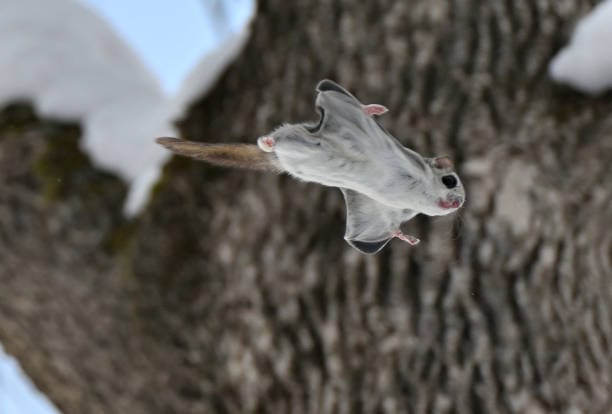
Physical Characteristics & Identification Tips
The Northern Flying Squirrel may seem out of place in Texas, yet it thrives in the cooler, forested parts of the Texas Panhandle. It’s easily recognized by its large, dark eyes, soft grayish-brown fur, and the thin membrane of skin called a “patagium” stretching between its front and hind legs. Adults measure about 10 to 13 inches long, with a flat, wide tail used as a steering rudder when gliding. Despite their name, they don’t truly fly—they glide gracefully between trees, sometimes covering 100 feet or more in a single leap.
Behavior
These nocturnal squirrels are active only at night, using their huge eyes and sensitive whiskers to navigate in darkness. They’re social and often nest in small groups during winter to conserve warmth. Unlike most Texas squirrels, they don’t hibernate, staying active year-round. They glide silently from tree to tree in search of food, communicating with soft chirps and ultrasonic calls beyond human hearing.
Habitat and Range
In Texas, Northern Flying Squirrels are limited to the forested canyons and pine-oak woodlands of the far north and northeast regions. They prefer mature forests with dense canopies, where gliding is easiest. Their nests are typically built in old woodpecker holes or natural cavities lined with moss and shredded bark.
Diet
Their diet includes fungi, acorns, lichens, nuts, and insects. They play a vital ecological role by spreading fungal spores that help trees absorb nutrients. This mutualistic relationship between squirrel and forest makes them keystone species in their ecosystems.
Reproduction and Life Cycle
Breeding occurs twice a year—in early spring and midsummer. Females bear two to four young per litter after a gestation period of around 40 days. The young begin gliding at about six weeks of age, learning from their mother’s example. Their lifespan averages five to six years in the wild.
Fun Facts / Unique Traits
The Northern Flying Squirrel’s gliding ability is a marvel of natural engineering. It uses its tail to steer and its body to control lift, landing with precision on tree trunks. Their eyes reflect a bright pink glow under flashlight—a telltale sign for nocturnal wildlife watchers. They’re also one of the few mammals that “cache fungi,” storing mushrooms on branches to dry and eat later.
Human Interaction
Because of their secretive, nocturnal habits, most Texans never see a Northern Flying Squirrel. However, wildlife biologists track their presence as indicators of healthy forest ecosystems. They’re not known to cause damage or invade homes. Spotting one gliding under moonlight is a magical, fleeting experience—proof that even in Texas, the wild still holds quiet mysteries above the treetops.
Frequently Asked Questions
1. How many squirrel species live in Texas?
Texas hosts about ten commonly recognized species and regional forms of squirrels, spanning tree, flying, and ground squirrels across varied habitats from pine forests to deserts.
2. What is the most common squirrel in Texas backyards?
The Eastern Gray and the Fox Squirrel are the species most often seen in suburban yards and parks, depending on region and tree availability.
3. Are flying squirrels dangerous to humans?
No. Flying squirrels are small, nocturnal, and shy. They generally avoid people and pose no threat; humane exclusion is recommended if they nest in buildings.
4. Do squirrels damage trees or gardens?
Occasionally. Tree squirrels may strip bark, chew fruit, or dig for planted bulbs. Ground squirrels can disturb lawns and garden beds. Most impacts are minor and can be managed with exclusion and habitat adjustments.
5. Can you feed squirrels in Texas?
While many enjoy feeding them, it’s usually better for wildlife to forage naturally. If feeding, offer unsalted nuts and avoid bread or processed foods; consider the potential for habituation.
6. How can I tell a ground squirrel from a chipmunk?
Ground squirrels generally have stockier bodies and different striping patterns. Chipmunks have distinct facial stripes and are smaller; ground squirrels often show spotted or banded backs.
7. When are squirrels most active?
Tree and ground squirrels are diurnal—active during daylight, especially mornings and late afternoons. Flying squirrels are nocturnal, active after dusk.
8. Do squirrels hibernate in Texas?
Some ground squirrels, like the Thirteen-Lined Ground Squirrel, hibernate in colder areas; many Texas species remain active year-round but may reduce activity in extreme conditions.
9. How do I discourage squirrels from nesting in my attic?
Seal entry points, install one-way exclusion doors for nesting animals to leave, and provide alternative nest boxes outside. Consult a wildlife rehabilitator or removal professional if needed.
10. Are any Texas squirrels protected by law?
Protections vary by species and jurisdiction. Some regions restrict taking or relocating wildlife without permits. Contact local wildlife authorities before attempting removal or relocation.
11. What role do squirrels play in Texas ecosystems?
Squirrels disperse seeds and fungal spores, aerate soil with burrowing, and serve as prey for raptors, foxes, and snakes—making them vital contributors to ecological balance.
12. What’s the best way to observe squirrels without disturbing them?
Use binoculars, move quietly, and sit at a distance with patience. Early morning or late afternoon offers the most activity; avoid sudden movements and keep dogs leashed to prevent scaring wildlife.
Final Thoughts
From the deserts of the west to the piney woods of the north, Texas hosts an incredible array of squirrel species. Each has evolved to master its niche—whether it’s gliding through the forest canopy, burrowing beneath mesquite roots, or sprinting across open plains. Observing these animals reminds us that even the most common creatures contribute to the state’s ecological tapestry. Whether you’re a wildlife photographer, a hiker, or simply a nature lover, take time to notice the squirrels of Texas—they’re far more varied and fascinating than most people realize.
Read more: 10 Types of Squirrels in Michigan (Pictures And Identification)
